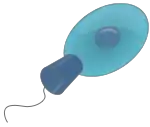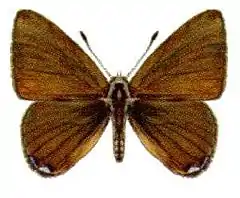ParaHoxozoa
The ParaHoxozoa is a proposed basal clade within the Eumetazoan animals, to be the sister group to the Ctenophora, and to contain nearly all the major animal groups. It consists of the Bilateria, the Placozoa and the Cnidaria.[1][2][3][4][5][6][7]
| ParaHoxozoa | |
|---|---|
| Scientific classification | |
| Kingdom: | Animalia |
| Subkingdom: | Eumetazoa |
| Clade: | ParaHoxozoa Ryan et al., 2010 |
| Clades | |
Characteristics
The Parahoxozoa group was defined by the presence of several gene (sub)classes (HNF, CUT, PROS, ZF, CERS, K50, S50-PRD), as well as Hox/ParaHox-ANTP from which the name of this clade originated. It was later proposed[8][9] and contested[10] that a gene of the same class (ANTP) as the Hox/ParaHox, the NK gene and the Cdx Parahox gene, is also present in Porifera, the sponges. Nevertheless, the Parahoxozoa as originally defined without Porifera may be monophyletic, and continues to be used as such.[4]
| Choanozoa |
| ||||||||||||||||||||||||||||||||||||||||||||||||
| (950 mya) |
The position of Placozoa is not clear, as it may be sister to the remaining Parahoxozoa (the Planulozoa hypothesis) or sister to the Cnidaria.
Planula-acoel, triploblasty, and bilaterian similarities
The original bilateria are hypothesized to be a bottom dwelling worm with a single body opening.[11] A through-gut may already have developed with the ctenophora however.[12] The through-gut may have developed from the corners of a single opening with lips fusing. E.g. Acoela resemble the planula larvae of some cnidaria, which exhibit some bilaterian symmetry. They are vermiformes, just as the cnidarian Buddenbrockia is.[13][14][15] Placozoa has been noted to resemble planula.[16] Usually, "Planulozoa" is to the exclusion of Placozoa, but not necessarily. In this case it appears synonymous with ParaHoxozoa.[17] Triploblasty developed before the Cnidara-Bilateria radiation as well.[18]
References
- Feuda, Roberto; Dohrmann, Martin; Pett, Walker; Philippe, Hervé; Rota-Stabelli, Omar; Lartillot, Nicolas; Wörheide, Gert; Pisani, Davide (2017). "Improved Modeling of Compositional Heterogeneity Supports Sponges as Sister to All Other Animals". Current Biology. 6 (24): 3864–3870.e4. doi:10.1016/j.cub.2017.11.008. PMID 29199080.
- Pisani, Davide; Pett, Walker; Dohrmann, Martin; Feuda, Roberto; Rota-Stabelli, Omar; Philippe, Hervé; Lartillot, Nicolas; Wörheide, Gert (15 December 2015). "Genomic data do not support comb jellies as the sister group to all other animals". Proceedings of the National Academy of Sciences. 112 (50): 15402–15407. Bibcode:2015PNAS..11215402P. doi:10.1073/pnas.1518127112. ISSN 0027-8424. PMC 4687580. PMID 26621703.
- Simion, Paul; Philippe, Hervé; Baurain, Denis; Jager, Muriel; Richter, Daniel J.; Franco, Arnaud Di; Roure, Béatrice; Satoh, Nori; Quéinnec, Éric (3 April 2017). "A Large and Consistent Phylogenomic Dataset Supports Sponges as the Sister Group to All Other Animals" (PDF). Current Biology (Submitted manuscript). 27 (7): 958–967. doi:10.1016/j.cub.2017.02.031. ISSN 0960-9822. PMID 28318975.
- Giribet, Gonzalo (1 October 2016). "Genomics and the animal tree of life: conflicts and future prospects". Zoologica Scripta. 45: 14–21. doi:10.1111/zsc.12215. ISSN 1463-6409.
- Laumer, Christopher E.; Gruber-Vodicka, Harald; Hadfield, Michael G.; Pearse, Vicki B.; Riesgo, Ana; Marioni, John C.; Giribet, Gonzalo (2018-10-30). "Support for a clade of Placozoa and Cnidaria in genes with minimal compositional bias". eLife. 7. doi:10.7554/elife.36278. ISSN 2050-084X. PMC 6277202. PMID 30373720.
- Ryan, Joseph F.; Pang, Kevin; Mullikin, James C.; Martindale, Mark Q.; Baxevanis, Andreas D. (2010-10-04). "The homeodomain complement of the ctenophore Mnemiopsis leidyi suggests that Ctenophora and Porifera diverged prior to the ParaHoxozoa". EvoDevo. 1 (1): 9. doi:10.1186/2041-9139-1-9. ISSN 2041-9139. PMC 2959044. PMID 20920347.
- Eitel, Michael; Francis, Warren; Osigus, Hans-Jürgen; Krebs, Stefan; Vargas, Sergio; Blum, Helmut; Williams, Gray Argust; Schierwater, Bernd; Wörheide, Gert (2017-10-13). "A taxogenomics approach uncovers a new genus in the phylum Placozoa". bioRxiv: 202119. doi:10.1101/202119.
- Fortunato, Sofia A. V.; Adamski, Marcin; Ramos, Olivia Mendivil; Leininger, Sven; Liu, Jing; Ferrier, David E. K.; Adamska, Maja (2014-10-30). "Calcisponges have a ParaHox gene and dynamic expression of dispersed NK homeobox genes". Nature. 514 (7524): 620–623. Bibcode:2014Natur.514..620F. doi:10.1038/nature13881. hdl:10023/6597. ISSN 0028-0836. PMID 25355364.
- Larroux, Claire; Fahey, Bryony; Degnan, Sandie M.; Adamski, Marcin; Rokhsar, Daniel S.; Degnan, Bernard M. (1996). "The NK Homeobox Gene Cluster Predates the Origin of Hox Genes". Current Biology. 17 (8): 706–710. doi:10.1016/j.cub.2007.03.008. PMID 17379523.
- Ryan, Joseph F.; DeBiasse, Melissa B.; Pastrana, Claudia C. (2019). "Sponges lack ParaHox genes". Genome Biology and Evolution. 11 (4): 1250–1257. doi:10.1093/gbe/evz052. PMC 6486804. PMID 30859199.
- Cannon, Johanna Taylor; Vellutini, Bruno Cossermelli; Smith, Julian; Ronquist, Fredrik; Jondelius, Ulf; Hejnol, Andreas (2016). "Xenacoelomorpha is the sister group to Nephrozoa". Nature (Submitted manuscript). 530 (7588): 89–93. Bibcode:2016Natur.530...89C. doi:10.1038/nature16520. PMID 26842059.
- Browne, William E.; Amemiya, Chris T.; Swalla, Billie J.; Warren, Kaitlyn J.; Vandepas, Lauren E.; Presnell, Jason S. (2016-10-24). "The Presence of a Functionally Tripartite Through-Gut in Ctenophora Has Implications for Metazoan Character Trait Evolution". Current Biology. 26 (20): 2814–2820. doi:10.1016/j.cub.2016.08.019. ISSN 0960-9822. PMID 27568594.
- Jiménez-Guri, Eva; Philippe, Hervé; Okamura, Beth; Holland, Peter W. H. (2007-07-06). "Buddenbrockia Is a Cnidarian Worm". Science. 317 (5834): 116–118. Bibcode:2007Sci...317..116J. doi:10.1126/science.1142024. ISSN 0036-8075. PMID 17615357.
- Baguñà, Jaume; Martinez, Pere; Paps, Jordi; Riutort, Marta (2008-04-27). "Back in time: a new systematic proposal for the Bilateria". Philosophical Transactions of the Royal Society B: Biological Sciences. 363 (1496): 1481–1491. doi:10.1098/rstb.2007.2238. ISSN 0962-8436. PMC 2615819. PMID 18192186.
- Genikhovich, Grigory; Technau, Ulrich (2017-10-01). "On the evolution of bilaterality". Development. 144 (19): 3392–3404. doi:10.1242/dev.141507. ISSN 0950-1991. PMID 28974637.
- Syed, Tareq; Schierwater, Bernd (2002). "The evolution of the placozoa: A new morphological model". Senckenbergiana Lethaea. 82 (1): 315–324. doi:10.1007/bf03043791. ISSN 0037-2110.
- Wallberg, Andreas; Thollesson, Mikael; Farris, James S.; Jondelius, Ulf (2004). "The phylogenetic position of the comb jellies (Ctenophora) and the importance of taxonomic sampling". Cladistics. 20 (6): 558–578. doi:10.1111/j.1096-0031.2004.00041.x. ISSN 0748-3007.
- Boero, F.; Schierwater, B.; Piraino, S. (2007-06-01). "Cnidarian milestones in metazoan evolution". Integrative and Comparative Biology. 47 (5): 693–700. doi:10.1093/icb/icm041. ISSN 1540-7063. PMID 21669750.




